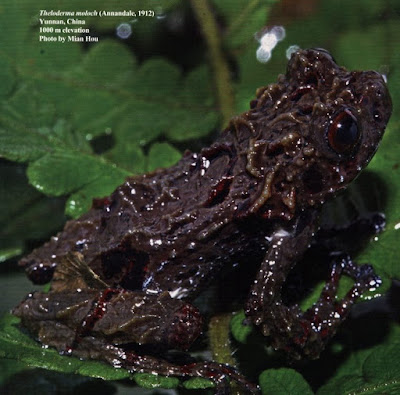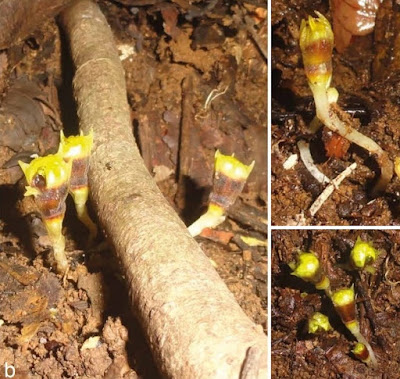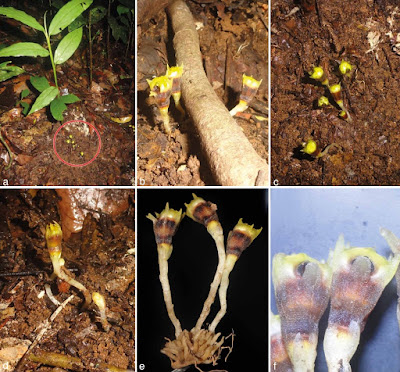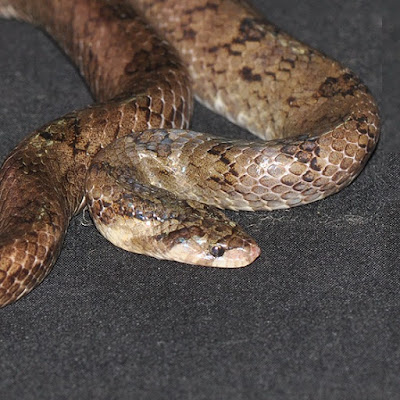[Most Recent Entries] [Calendar View]
Wednesday, July 19th, 2017
| Time | Event | ||||
| 2:45a | [Herpetology • 2017] The Taxonomic Status and Distribution Range of Six Theloderma Species (Anura: Rhacophoridae) with A New Record in China
Abstract The problems of identification, number and distribution of Theloderma species living in China are discussed on the base of new original morphological and molecular data collected during the last years. According to the author’s results there are six known Theloderma species living in China: Theloderma albopunctatum (Liu et Hu, 1962), Theloderma baibungense Jiang, Fei et Huang, 2007, Theloderma bicolor (Bourret, 1937), Theloderma corticale (Boulenger, 1903), Theloderma moloch (Annandale, 1912), and Theloderma rhododiscus Liu et Hu, 1962. Keywords: taxonomy; distribution; Theloderma; new records; China Theloderma corticale (Boulenger, 1903) English name. Tonkin Bug-eyed Frog, Kwangsi Warty Treefrog. Etymology. The specific epithet is derived from Latin “cortex,” genit. cortices or corticulus, means bark.Distribution. Known from south China, Laos, and Vietnam. Theloderma bicolor (Bourret, 1937) English name. Chapa Bug-eyed Frog. Etymology. the specific epithet is derived from Latin “bis,” means two, twice; and color is from Latin “color,” as hue, tint or complexion.Distribution. Northwest to central Vietnam; southwest China. Theloderma moloch (Annandale, 1912) Theloderma asperum species group, such as Theloderma albopunctatum (southern China to central Indochina), Theloderma baibungense (SE Himalaya) and T. asperum (south Indochina to Malaysian Peninsula). Theloderma rhododiscus Liu et Hu, 1962 .... According to above discussion, currently there are six known Theloderma species in China, such as Theloderma albopunctatum (Liu et Hu, 1962), Theloderma baibungense Jiang, Fei et Huang, 2007, Theloderma bicolor (Bourret, 1937), Theloderma corticale (Boulenger, 1903), Theloderma moloch (Annandale, 1912), and Theloderma rhododiscus Liu et Hu, 1962 Hou Mian, Yu Guo-Hua, Chen Hong-man, Liao Chang-Le, Zhang Li, Chen Jin, Li Pi-Peng and Nikolai L. Orlov. 2017. The Taxonomic Status and Distribution Range of Six Theloderma Species (Anura: Rhacophoridae) with A New Record in China. Russian Journal of Herpetology. 24(2); 91-127. ResearchGate.net/project/Theloderma-Taxonomy-of-China Theloderma in China (Anura: Rhacophoridae); Taxonomic Status and Distribution Range | ||||
| 11:42a | [Botany • 2017] Thismia sahyadrica • The First Record of the Mycoheterotrophic Genus, Thismia (Thismiaceae), to the Flora of India with A New Species Revealing the Phytogeographical Significance of Western Ghats
Abstract Thismia, a genus of mycoheterotrophic plants, is reported for the first time from mainland India, from Neryamangalam forests in Idukki district of Kerala, along with a new species, T. sahyadrica. Thismia sahyadrica, described and illustrated here, is unique within Thismia in having a mitre with a single opening; five perianth lobes are fused into a mitre-like structure, while the sixth one is free, forming a lateral single opening of the flower. Due to its unique morphological characteristics, the taxonomic placement of the new species remains obscure, although some root and flower characters suggest an affinity with species from the sections Glaziocharis, Sarcosiphon, Geomitra, and Scaphiophora. Ecological specificity and phytogeographical peculiarities of the new species are also discussed. Keywords: Kerala; Thismia; Western Ghats; mycoheterotrophy
Thismia sahyadrica Sujanapal, Robi & Dantas, sp. nov. Thismia sahyadrica differs from all other species of Thismia in having a mitre with a single opening; it is further characterized by a brownish hypanthium, greenish yellow perianth lobes, a yellow ovary, and two fused outer perianth lobes and spreading third one. — Type: A.J. Robi & K.J. Dantas 28097 (holotype KFRI; isotypes CALI, K, L, MH), India, Kerala, Idukki dist., Neryamangalam, ± 500 m, 14 July 2014. Etymology. The specific epithet ‘sahyadrica’ refers to the Sahyadri HillsWestern Ghats, where the type locality of the species is located. P. Sujanapal, A.J. Robi, K.J. Dantas, M. Sumod and V.S.F.T. Merckx. 2017. Thismia (Thismiaceae): The First Record of the Mycoheterotrophic Genus to the Flora of India with A New Species Revealing the Phytogeographical Significance of Western Ghats. Blumea - Biodiversity, Evolution and Biogeography of Plants. 62; 97–102. DOI: 10.3767/blumea.2017.62.2.04 A plant that makes cameo appearance when rain subsides http://www.thehindu.com/sci-tech/science/A-p | ||||
| 3:50p | [Herpetology • 2017] Oligodon saiyok | งูงอดไทรโยค • A New Limestone-dwelling Kukri Snake (Serpentes: Colubridae) from Kanchanaburi Province, western Thailand
Abstract We describe Oligodon saiyok sp. nov. from Benjarat Nakhon Cave Temple, Sai Yok District, Kanchanaburi Province, western Thailand. It is characterized by a maximal known SVL of 626.1 mm; 13 maxillary teeth, the posterior two enlarged; 8 supralabials; 17-17-15 dorsal scale rows; 181–187 ventrals and 38–43 subcaudals; a single anal; hemipenes extending in situ to the 18th subcaudal; dorsum with 21–22 dark blotches or white rings without vertebral or lateral stripes; and venter with a dense network of subrectangular dark blotches. It is the 7th squamate species believed to be endemic to Sai Yok District. Keywords: Reptilia, Thailand, Oligodon saiyok sp. nov., new species, taxonomy, limestone cave, Buddhist temple
Etymology. The specific epithet is an invariable noun in honor of the administrative district where the type locality lies. We suggest the following common names: Ngu Ngod Sai Yok - งูงอดไทรโยค (Thai), Sai Yok Kukri Snake (English),Oligodon de Saï Yok (French), and Sai Yok Kukrinatter (German). .... Oligodon saiyok sp. nov. increases the already exceptionally high number of squamates endemic to Sai Yok District, still unexplained to date: Cnemaspis huaseesom Grismer, Sumontha, Cota, Grismer, Wood, Pauwels & Kunya, 2010, Cyrtodactylus saiyok Panitvong, Sumontha, Tunprasert & Pauwels, 2014 and C. tigroides Bauer, Sumontha & Pauwels, 2003, Dixonius hangseesom Bauer, Sumontha, Grossmann, Pauwels & Vogel, 2004, Gekko nutaphandi Bauer, Sumontha & Pauwels, 2008, and Trimeresurus kanburiensis Smith, 1943 (see David et al. 2004). .... Montri Sumontha, Kirati Kunya, Siriwat Dangsri and Olivier S. G. Pauwels. 2017. Oligodon saiyok, A New Limestone-dwelling Kukri Snake (Serpentes: Colubridae) from Kanchanaburi Province, western Thailand. Zootaxa. 4294(3); 316–328. DOI: 10.11646/zootaxa.4294.3.2 ResearchGate.net/publication/318529308_O |
| << Previous Day |
2017/07/19 [Calendar] |
Next Day >> |









